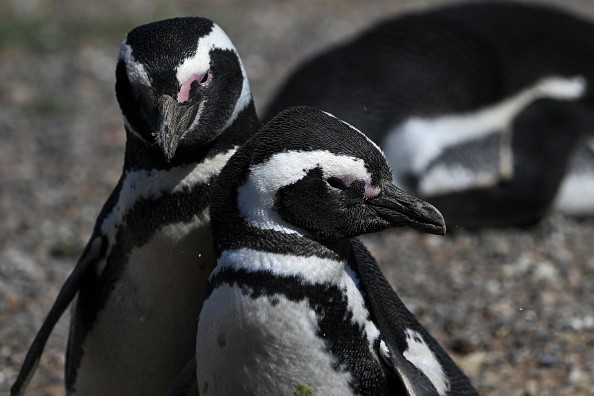Climate change will impact ecosystems in two ways: short-term, intense occurrences, known as "pulses," and long-term changes, known as "presses."
Understanding the consequences of presses and pulses is critical as conservationists and policymakers work to protect ecosystems and defend species.
Over nearly four decades, researchers discovered how different presses and pulses impacted Magellanic penguins (a migratory marine predator) and discovered that, while individual presses and pulses impacted penguins in a variety of ways, both were equally important for the penguin population's future survival.
They also discovered that these sorts of climatic changes are causing an overall population drop at their historically greatest breeding location.
Climate 'presses' and 'pulses' impact Magellanic penguins
 (Photo : LUIS ROBAYO/AFP via Getty Images)
(Photo : LUIS ROBAYO/AFP via Getty Images)

Over nearly four decades, researchers at the University of Washington investigated how different pressures and pulses influenced Magellanic penguins at their historically greatest nesting location in Punta Tombo, Argentina, as per ScienceDaily.
The team from the University of Washington's Center for Ecosystem Sentinels reports in a paper published the week of Jan. 9 in the Proceedings of the National Academy of Sciences that, while individual presses and pulses impacted penguins in different ways, both were equally important for the penguin population's future survival.
They also discovered that these sorts of climatic changes, when combined, are causing an overall population drop at this specific place.
"We discovered that penguin survival is not dependent entirely - or even mostly - on one or a few climatic impacts," said T.J. Clark-Wolf, a UW postdoctoral researcher in biology and center scientist.
Rather, a variety of pushes and pulses influence penguin reproduction and survival across time.
Clark-Wolf and senior author Briana Abrahms, a UW associate professor of biology, combined these data into an integrated population model that disentangled the effects of individual pushes and pulses on penguin survival over time.
They discovered that various climatic influences had diverse effects on the Punta Tombo population.
Heat waves, for example, have a negative impact on the population by killing both adults and chicks, as demonstrated by a 2019 single-day heat wave in Punta Tombo that killed more than 350 penguins.
Increased rainfall at the location, according to a climate press, has also had a detrimental influence on the population, because storms during the mating season kill chicks due to exposure.
One aspect that helped penguin survival was the progressive reduction of the plume of sediment thrown into the ocean by the Rio de la Plata, South America's second biggest river basin.
This push has an influence on the winter-feeding waters of penguins off the coasts of northern Argentina, Uruguay, and Brazil.
Ginger Rebstock, a co-author on the current study and a UW research scientist, has previously suggested that a thinner plume may make it easier for penguins, particularly females, to gather enough food each winter and return to the mating location in great shape.
However, the good impacts of a diminishing plume could not outweigh the negative consequences of other climatic events at Punta Tombo, which has gotten warmer and wetter over almost four decades.
The number of breeding pairs at the site has decreased from 400,000 in the early 1980s to around 150,000 in 2019.
According to surveys, Magellanic penguins are forming new breeding colonies further north along the South American coast in quest of improved food options.
According to the researchers, understanding how these pushes and pulses shape this population is critical for influencing conservation efforts.
Also Read: Throwback: Dindim the Penguin Travels 5,000 Miles Every Year to Visit His Rescuer in Brazil
Magellanic Penguins
The Magellanic Penguin was named after Ferdinand Magellan, who observed the bird on his first expedition across South America in 1519, as per the World Land Trust.
These penguins stand 70cm tall and weigh about four kg.
Their black and white feathering is extremely thick, with over 70 feathers per square inch and a waterproof oil covering that keeps them warm.
When swimming in the ocean, its "tuxedo" helps the bird conceal itself from predators.
The white belly mixes in with the strong light from above, making the bird difficult to identify for seals, and the black back blends in with the dark water below from above.
Magellanic Penguins travel to the beach to procreate, building nests under shrubs or tunnels beneath rocks.
They lay two eggs on average, and both parents nurture the fluffy grey chicks until they moult and can go out to sea to forage for themselves.
Oil spills, becoming caught in fishing nets, and overfishing of their environment all pose dangers to the birds' food source of squid and small fish.
Magellanic penguins also lose burrows during guano mining (bird droppings).
Related article: Emperor Penguin: World's Largest Penguins Join the Threatened Species List Due to Climate Change and Global Warming
© 2024 NatureWorldNews.com All rights reserved. Do not reproduce without permission.



![Climate Change is Reducing Dust Levels Worldwide as Arctic Temperature Warms [Study]](https://1471793142.rsc.cdn77.org/data/thumbs/full/70320/280/157/50/40/climate-change-is-reducing-dust-levels-worldwide-as-arctic-temperature-warms-study.jpg)
![Tsunami Hazard Zones: New US Map Shows Places at Risk of Flooding and Tsunamis Amid Rising Sea Levels [NOAA]](https://1471793142.rsc.cdn77.org/data/thumbs/full/70325/280/157/50/40/tsunami-hazard-zones-new-us-map-shows-places-at-risk-of-flooding-and-tsunamis-amid-rising-sea-levels-noaa.jpg)
